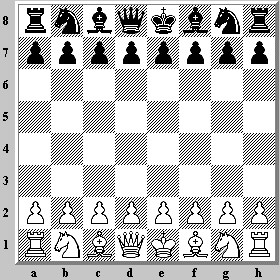
The
'hanging pawns' structure arises in many openings and is closely
related to the isolani. In fact, most hanging pawns arise from an
isolani position, in which Black trades his knight on d5 for White's
knight on c3. Later, White is likely to advance c3-c4 yielding the
position in the diagram. Similar to the previous chapter, this
structure is equally likely to arise with either colour, but for the
moment we will assume it is White who has the hanging pawns. In
general, White has better middlegame prospects due to his control of
central squares and his spatial edge. Black, on the other hand,
should aim for an endgame or a simplified position in which these
pawns are likely to become a liability. In particular, if these pawns
become blocked by Black's pieces, then they will become a crucial
weakness accounting for an essentially lost position. Now, let's
discuss specific ideas for both sides.
White's
plans :
1.
Create a kingside attack. Most plans will include the moves e5, c2,
d3, and a likely rook transfer through the third rank, say with gel
-e3-h3.
2.
Break in the centre with d4-d5, either to open lines for attack, or
to create a powerful passed pawn on the d-file.
Black's
plans :
1.
Trade off pieces attempting to neutralize the attack. 2. Pressure the
central pawns, block them if possible. 3. Break the hanging pawns,
either with ... b6-b5 or ... e6-e5. These breaks are not easy to
carry out, especially because an experienced player will try and
prevent them at all costs. However, if they can be accomplished they
are generally very strong, as they weaken those squares covered by
the hanging pawns, and often force White to accept an isolani under
very unfavorable circumstances.
As
the reader will notice, many ideas are shared between this structure
and the previous one, and this should not be a surprise. These
structures are members of the same family in a general sense. They
are both open positions in which White enjoys a pleasant spatial
advantage at the cost of some structural instability. Overall, I
would say the standard hanging pawns position offers level chances
and a complex game with winning chances for both sides. Precise
calculation is often required to carry out (or neutralize) the attack
and to find the right timing for the central breaks mentioned above.
The
first two games in this chapter will illustrate how White may
successfully break in the centre with d4-d5. In the first example
this break will create a decisive attack due to the opening of lines,
while the second example will illustrate the power of a passed pawn
advancing down the d-file. The third game is an illustration
ofWhite's attacking potential within a modified structure which often
arises from the hanging pawns. The last three games in the chapter
illustrate (with reversed colours) how Black may play against the
hanging pawns. The first of these games illustrates the blocking of
the hanging pawns, while the last two exemplify the breaks ... e6-e5
and ... b6-b5 respectively.
x
0 comments:
Post a Comment